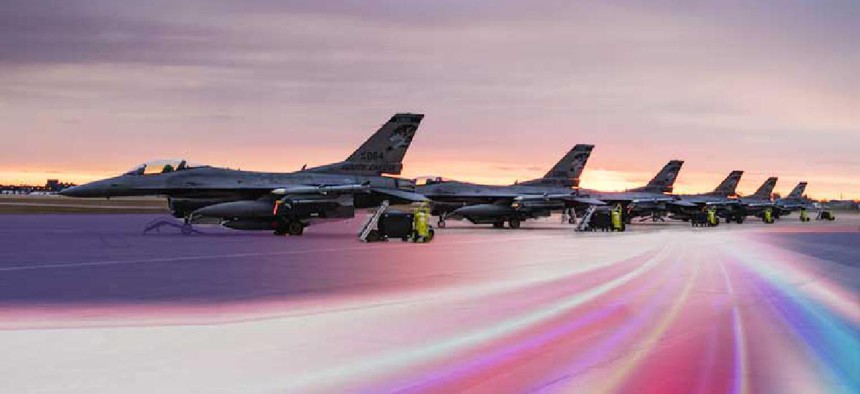Air Force expands 5G to Reserve Command installations
The addition of commercial cellular infrastructure will enable reservists and responders to work more efficiently at the edge.
The Defense Department is expanding the number of bases using 5G with a contract to provide the service to seven Air Force Reserve Command (AFRC) installations.
Announced Sept. 21, the contract puts Verizon Public Sector in charge of delivering its 5G Ultra Wideband mobility service to bases in California, Florida, Massachusetts, New York, Ohio, Pennsylvania and Texas. The deployment will feature C-band radios installed outdoors at each AFRC location and a combination of 4G and 5G mmWave frequency indoors, bringing higher speeds, increased bandwidth and lower latency for base personnel and the surrounding community.
“Connectivity is a challenge across our bases, where approximately two-thirds of our facilities do not have sufficient coverage or capacity for mobile device productivity and communication,” said Kenneth Morgan, AFRC’s chief information technology officer. “Enabling connectivity allows the operator, maintainer, defender or first responder to enhance capabilities. Historically, the communication has been limited to land mobile radio, voice-only devices. The enriched capabilities of voice, text and video are significant.”
The additional capabilities of 4G and 5G will enable reservists to work more efficiently at the edge. For instance, they won’t have to travel to a facility with wired connectivity to document aircraft maintenance. They can have a library of aircraft flight and maintenance manuals, which can consist of thousands of pages equal to 30 to 60 gigabytes, at their fingertips on their device.
Other potential benefits Morgan cited include real-time collaboration with tools such as Microsoft Teams that reservists can use to support engineers fixing a jet thousands of miles away, operators accessing the latest weather updates from the end of the runway, airmen performing nonroutine tasks by watching a how-to video while stepping through technical manual procedures, and the consolidation of devices and information into a single form factor.
“In the past, the airman would have a land mobile radio, paper technical manuals, paper aircraft flight plan,” Morgan said. “Engineering support required a lengthy paper-based process.”
The connectivity will also allow for the developments of augmented and virtual reality simulators and trainers; full-motion, high-definition video to support telemedicine; and ultra-fast artificial intelligence for biometric identification.
What’s more, the bases can now operate as smart cities, freeing personnel from routine operations by using autonomous systems, Morgan said. “The addition of commercial cellular infrastructure consisting of macro towers, small cells and in-building solutions is a game-changer.”
The work builds on DOD’s Offer to Lease (OTL) project, a three-phase approach to connectivity. The first two phases went to Verizon in 2019, and three of AFRC’s 10 host base installations are complete. The seven that remain are part of what’s called Phase 2b.
“In coordination with Headquarters Air Force and [the Air Force Civil Engineering Center], the command proposed a singular major command approach to not only accelerate the command, but potentially accelerate the larger Air Force project as well,” Morgan said. “Now with Air Force Reserve, the Air Force has a total of 37 bases under the OTL project with commercial industry. Specifically for the Air Force Reserve, this will establish a baseline across all of our host bases and headquarters, facilitating the standardization of capabilities available to the warfighter.”
Lessons learned from the previous work include better understanding of how bases conduct the facilities utilization board integration of support requirements, DOD/Air Force radio frequency spectrum analysis, environmental requirements and how to use commercial infrastructure to meet mission current and emerging needs, he said.
Morgan said he expects that by the end of 2023, the phases of the project that pertain to AFRC bases will be complete, expanding coverage and capacity for more than 500 facilities supporting more than 30,000 Reserve Citizen Airmen.
Phase 2b aligns with two larger efforts. One is the Air Force chief of staff’s strategic approach known as “Accelerate Change or Lose.” Released in August 2020, it calls for “innovation, experimentation and rapid prototyping, and a collaborative approach with our service and industry teammates” to be defense-ready.
The other is a strategic priority to reform “our organizations to optimize our warfighting capabilities” that Richard Scobee, chief of the Air Force Reserve and commander of AFRC, and Command Chief Timothy White set.
Other branches of the military are also testing 5G. The Naval Postgraduate School is working with AT&T on maritime solutions, and a year ago DOD announced $600 million for 5G experimentation and testing at five sites, including Marine Corps Logistics Base Albany, Ga., which has studied 5G-enabled smart warehousing.
This article first appeared on GCN, a Defense Systems partner site.
NEXT STORY: CMMC's Arrington sues DOD to clear her name




